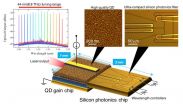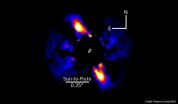INFORMATION:
This research was partially supported by the Strategic Information and Communications R&D Promotion Program (SCOPE) of Japan's
Ministry of Internal Affairs and Communications. END
New heterogeneous wavelength tunable laser diode for high-frequency efficiency
2015-06-02
(Press-News.org) Researchers at Tohoku University and the National Institute of Information and Communications Technology (NICT) in Japan, have developed
a novel ultra-compact heterogeneous wavelength tunable laser diode. The heterogeneous laser diode was realized through a combination
of silicon photonics and quantum-dot (QD) technology, and demonstrates a wide-range tuning-operation.
The researchers presented their work at a Conference on Lasers and Electro-Optics (CLEO) in San Jose, California, on May 13. The related
paper was also be published in Applied Physics Express vol. 8, 062701 on May 20.
Recent high-capacity optical transmission systems are based on wavelength-division multiplexing (WDM) systems with dense frequency
channels. The frequency channels in C-band (conventional band: 1530- 1565 nm) are overcrowded and the frequency utilization efficiency is
saturated in such WDM systems. On the other hand, extensive and unexploited frequency resources are buried in near-infra-red
wavelengths (1000-1300 nm). Additionally, photonic devices are required to have smaller footprints and lower power consumption in short-
reach data transmission. The compact and low power consumption wavelength tunable laser diode is a key device to tap the undeveloped
frequency bands for higher capacity data transmission systems.
The heterogeneous wavelength tunable laser diode, consisting of the QD and the silicon photonics, is a promising candidate to realize such a
compact and broad-band light source. This is because the QD has large optical gains of around 1000 -1300 nm wavelength, and silicon
photonics provide a promising platform for highly integrated photonics devices - so a novel wavelength-tunable laser diode, combining QD
and silicon photonics technologies, was proposed.
The cooperative research group led by Tomohiro Kita and Naokatsu Yamamoto demonstrated a wide range tuning operation of around 1250
nm wavelength with an ultra-small device footprint. The obtained frequency tuning-range of 8.8 THz is a world record for the category of
QD and silicon photonics heterogeneous wavelength tunable laser diodes. It is expected that the fusing of the QD technology and silicon
photonics will provide a breakthrough for the development of an effective and compact light source.
ELSE PRESS RELEASES FROM THIS DATE:
High-temperature superconductivity in atomically thin films
2015-06-02
A research group at Tohoku University has succeeded in fabricating an atomically thin, high-temperature superconductor film with a superconducting transition temperature (Tc) of up to 60 K (-213°C). The team, led by Prof. Takashi Takahashi (WPI-AIMR) and Asst. Prof. Kosuke Nakayama (Dept. of Physics), also established the method to control/tune the Tc.
This finding not only provides an ideal platform for investigating the mechanism of superconductivity in the two-dimensional system, but also paves the way for the development of next-generation nano-scale superconducting ...
Astronomers discover a young solar system around a nearby star
2015-06-02
An international team led by Thayne Currie of the Subaru Telescope and using the Gemini South telescope, has discovered a young planetary system that shares remarkable similarities to our own early solar system. Their images reveal a ring-like disk of debris surrounding a Sun-like star, in a birth environment similar to the Sun's. The disk appears to be sculpted by at least one unseen solar system-like planet, is roughly the same size as our solar system's Edgeworth-Kuiper Belt (commonly called the Kuiper Belt), and may contain dust and icy particles. This work provides ...
'Climate-change skeptics are more ambivalent than we thought'
2015-06-02
Using a brand new survey method, researchers in Bergen have asked a broad spectrum of people in Norway about their thoughts on climate change. The answers are quite surprising.
Some 2,000 Norwegians have been asked about what they think when they hear or read the words "climate change". There were no pre-set answers or "choose the statement that best describes your view" options. Instead the respondents had to formulate their views on climate change in their own words. The answers have provided striking new insight into what the average person on the street in Norway ...
Childhood trauma gets under the skin
2015-06-02
Long-term changes in immune function caused by childhood trauma could explain increased vulnerability to a range of health problems in later life, according to new research by the Institute of Psychiatry, Psychology & Neuroscience (IoPPN) at King's College London and the NIHR Maudsley BRC.
The study, published today in Molecular Psychiatry, found heightened inflammation across three blood biomarkers in adults who had been victims of childhood trauma. High levels of inflammation can lead to serious and potentially life-threatening conditions such as type-2 diabetes, cardiovascular ...
FDA addresses concerns on approval of drugs to treat chronic hepatitis C
2015-06-02
Treatment options for chronic hepatitis C, a serious and life-threatening infection, have improved substantially and several new regimens with shorter durations and improved efficacy and safety profiles are now available.
Groups have raised concerns about the evidence used to support the approval of some newer drugs, however, and the issue has been used to cast doubt on their efficacy and even to question treatment or deny reimbursement.
To address these concerns, the US Food and Drug Administration's Division of Antiviral Products in the Center for Drug Evaluation ...
Douglas study on cerebral astrocytes in depression and suicide
2015-06-02
This news release is available in French. Montreal, June 2 -- A new study published by the team of Naguib Mechawar, Ph.D., a researcher with the McGill Group for Suicide Studies (MGSS) of the Douglas Institute (CIUSSS de l'Ouest-de-l'Ile de Montreal) and associate professor in the Department of Psychiatry at McGill University, sheds new light on the disruption of astrocytes in depression. Astrocytes, a class of non-neuronal cells, have previously been implicated in depression and suicide.
However, it was not known whether these cells were affected throughout the brain ...
Interpersonal conflict is the strongest predictor of community crime and misconduct
2015-06-02
Los Angeles, CA (June 2, 2015) Neighborhoods with more interpersonal conflict, such as domestic violence and landlord/tenet disputes, see more serious crime according to a new study out today in Journal of Research in Crime and Delinquency (JRCD). Private conflict was a better predictor of neighborhood deterioration than public disorder, such as vandalism, suggesting the important role that individuals play in community safety.
"Private conflicts, for example, domestic violence or friendship disputes over money or girlfriends, can and do spill over into public spaces, ...
Infant brains develop years faster than we thought
2015-06-02
Scientists from the University of Louvain have discovered that a key element of infant brain development occurs years earlier than previously thought.
The way we perceive faces -- using the right hemisphere of the brain -- is unique and sets us apart from non-human primates. It was thought that this ability develops as we learn to read, but a new study published in the journal eLife shows that in babies as young as four months it is already highly evolved.
"Just as language is impaired following damage to the brain's left hemisphere, damage to the right hemisphere ...
Kids' altruism linked with better physiological regulation, less family wealth
2015-06-02
Children as young as 4 years old may reap better health from altruistic giving, a behavior that tends to be less common among kids from high-income families, according to new research on the nature and nurture of altruism published in Psychological Science, a journal of the Association for Psychological Science.
"The findings provide us with a new understanding of how children's altruistic behaviors, family wealth, and physiological health are intertwined," says psychological scientist and lead researcher Jonas Miller of the University of California Davis.
Previous ...
Teens turn to Internet to cope with health challenges
2015-06-02
EVANSTON, Ill. --- At a time when teenagers are grappling with new and often confusing health concerns, the overwhelming majority -- 84 percent -- turn to the Internet, according to the first national study in more than a decade to examine how adolescents use digital tools for health information.
But while most teens tap online sources to learn more about puberty, drugs, sex, depression and other issues, a surprising 88 percent said they do not feel comfortable sharing their health concerns with Facebook friends or on other social networking sites, according to the study ...



